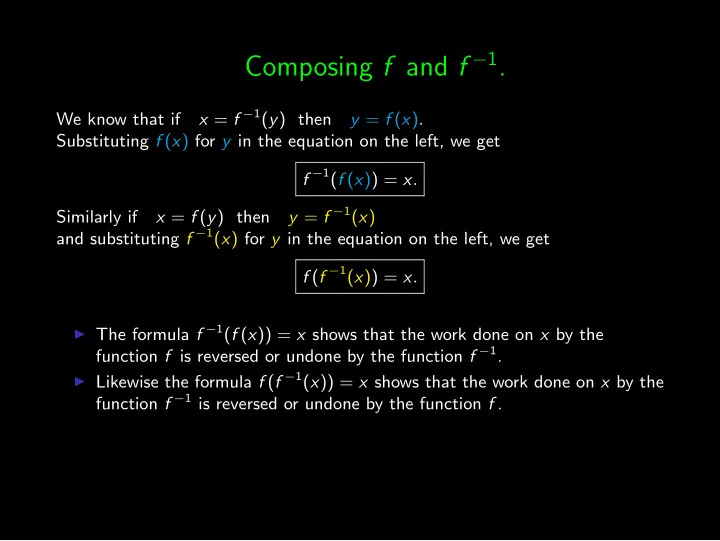

Composing f and f − 1 . x = f − 1 ( y ) then We know that if y = f ( x ) . Substituting f ( x ) for y in the equation on the left, we get f − 1 ( f ( x )) = x . y = f − 1 ( x ) Similarly if x = f ( y ) then and substituting f − 1 ( x ) for y in the equation on the left, we get f ( f − 1 ( x )) = x . ◮ The formula f − 1 ( f ( x )) = x shows that the work done on x by the function f is reversed or undone by the function f − 1 . ◮ Likewise the formula f ( f − 1 ( x )) = x shows that the work done on x by the function f − 1 is reversed or undone by the function f .
Composing f and f − 1 : Example For the purposes of demonstration, lets look at our example from above, where we worked out an explicit formula for f − 1 for the one-to-one function f ( x ) = 2 x +1 x − 3 . ◮ Above, we found that if f ( x ) = 2 x +1 x − 3 , then f − 1 ( x ) = 3 x +1 x − 2 . ◮ We can check the above formula for the composition: � � 3 x +1 2 +1 � � x − 2 (6 x +2+ x − 2) / ( x − 2) 3 x +1 (3 x +1 − 3 x +6) / ( x − 2) = 7 x f ( f − 1 ( x )) = f = = 7 = x . x − 2 � � 3 x +1 − 3 x − 2 ◮ We can also check the second formula for the composition � � 2 x +1 3 +1 f − 1 ( f ( x )) = f − 1 � � x − 3 (6 x +3+ x − 3) / ( x − 3) 2 x +1 (2 x +1 − 2 x +6) / ( x − 3) = 7 x = = 7 = x . x − 3 � � 2 x +1 − 2 x − 3
Encoding with a function The concept of an inverse function that undoes the work of a function is quite intuitive if you think of what happens with message encryption. ◮ Suppose I want to send a message to my friend that says “I love math” but I don’t want anyone else who sees the message to know what it says. ◮ I might first replace the letters of the alphabet by a number, A → 1, B → 2, etc... and then apply the function f ( x ) = 2 x + 1 to each number. . A B C D E F G H I J K L M x 1 2 3 4 5 6 7 8 9 10 11 12 13 y = 2 x+1 3 5 7 9 11 13 15 17 19 21 23 25 27 ◮ N O P Q R S T U V W X Y Z x 14 15 16 17 18 19 20 21 22 23 24 25 26 y= 2 x +1 29 31 33 35 37 39 41 43 45 47 49 51 53 . ◮ My message becomes “(19) (25)(31)(45)(11) (27)(3)(41)(17)”.
Decoding with the Inverse functions To decode my message “(19) (25)(31)(45)(11) (27)(3)(41)(17)” my friend might carry around that cumbersome table above for reference or she might just use the formula for the inverse function to reverse the work done on the x values by the function f ( x ) = 2 x + 1. ◮ Note that when sending the coded message, it was crucial that the function f ( x ) was one-to-one to avoid having two letters encoded by the same number, which would send an ambiguous message. Recall to find the inverse for f ( x ), we solve for x in y = 2 x + 1 to get ◮ x = y − 1 2 . ◮ Now we switch the x and y to get the equation y = x − 1 and 2 f − 1 ( x ) = x − 1 . 2 ◮ Thus to revers the work done by f and decode the message, my friend can apply f − 1 to each number in the message and that gives the position of the corresponding letter in the alphabet. ◮ We get f − 1 (19) = 18 / 2 = 9 which gives the ninth letter in the alphabet “I”, etc...
Recommend
More recommend